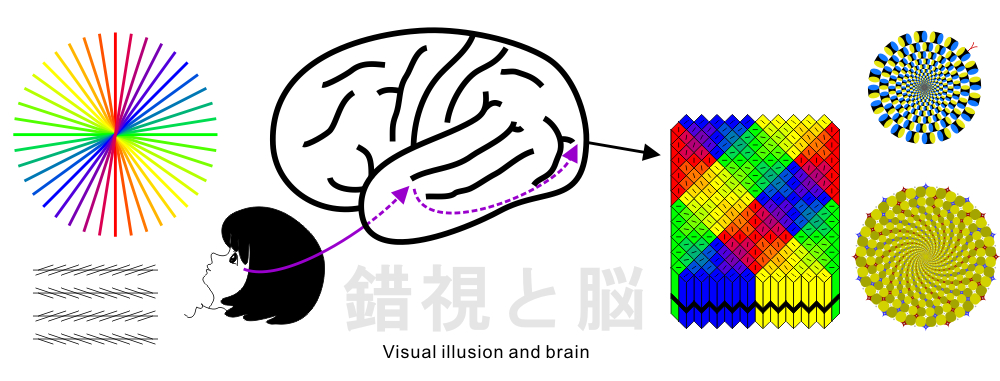
平成19年度 医学共通講義III
新基盤生命学:機能生物学入門
(機能生物学セミナー・グローバルCOE特別セミナー)
2月18日(月) 統合生理学(宮下保司先生ご担当)

北岡 明佳(Akiyoshi Kitaoka)
(立命館大学(Ritsumeikan University) 文学部 心理学専攻) email
since February 14, 2008
Today's talk
1. Contrast-dependent motion illusion
2. "Rotating snakes" illusion
3. Oblique-line-type motion illusion
4. Spiral illusion
5. Color illusion
1. Contrast-dependent motion illusion
an illusion that parts of low contrast appear to lag behind those of high
contrast
コントラスト依存の静止画が動いて見える錯視
低コントラストの領域は高コントラストの領域に比べて遅れて見えることによる錯視
"Fluttering hearts"
Hearts appear to flutter. For those those who wear glasses, try to move them; then the hearts appear to move. For the majority, the hearts appear to be in front of the surface of white random dots when they are bright, while they appear to be behind it when they are dark.
Copyright Akiyoshi .Kitaoka 2006 (December 20)
References
Kitaoka, A. and Ashida, H. (2007) A variant of the anomalous motion illusion based upon contrast and visual latency. Perception, 36, 1019-1035.PDF
Kitaoka, A, Kuriki, I. and Ashida, H. (2006) The center-of-gravity model of chromostereopsis. Ritsumeikan Journal of Human Sciences, 11, 59-64. PDF
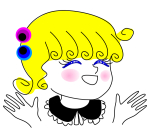 Handout the image shown above
Handout the image shown above
and
北岡明佳 (2006) 色が強くなる錯視 A・F・Tジャーナル, 31 (Summer), pp. 01.
2. "Rotating snakes" illusion
an illusion that repeated patterns appear to move in the constant direction
「蛇の回転」錯視
ある繰り返しパターンが、何もしなくても一定の方向に動いて見える錯視
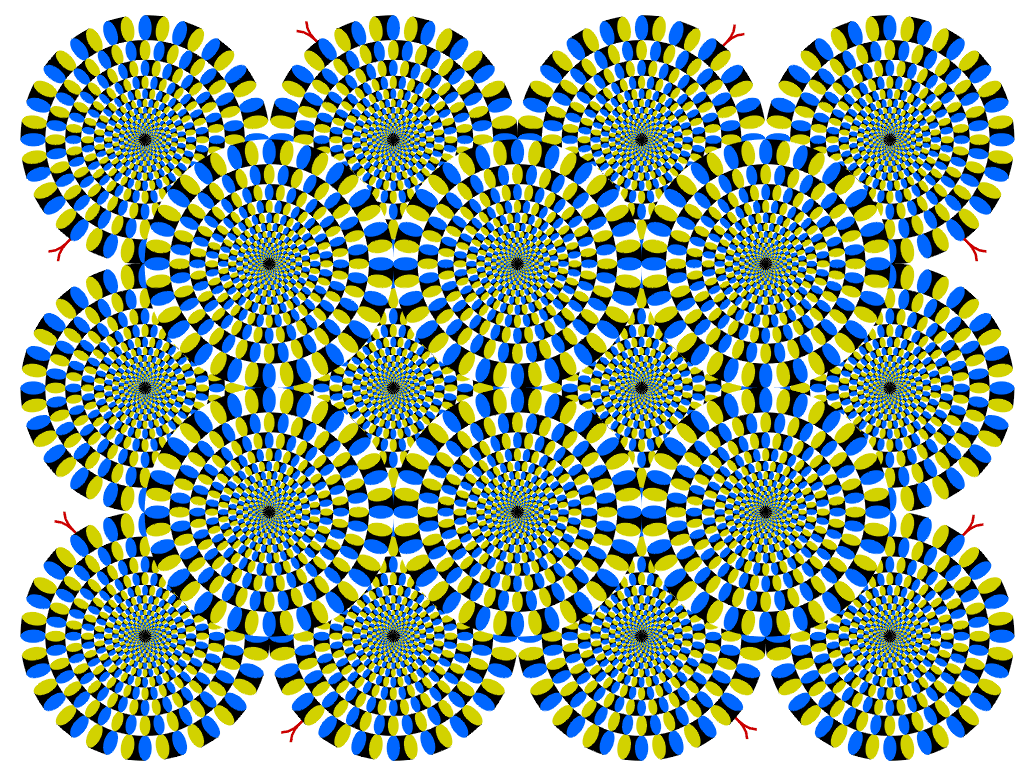
"Rotating snakes"
Circular snakes appear to rotate 'spontaneously'.
Copyright A.Kitaoka 2003 (September 2, 2003)
 Handout the image shown above
Handout the image shown above
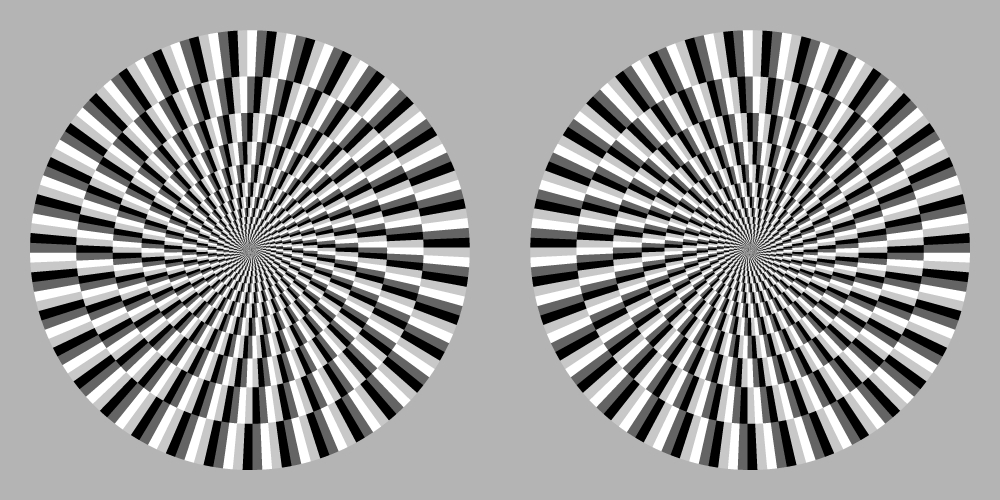
"Optimized Fraser-Wilcox" illusion
Kitaoka, A. and Ashida, H. (2003) Phenomenal characteristics of the peripheral drift illusion. VISION (Journal of the Vision Society of Japan), 15, 261-262. PDF
The direction of illusory motion is:
Black -> dark gray -> white -> light gray -> black
Tentative classification of this illusion
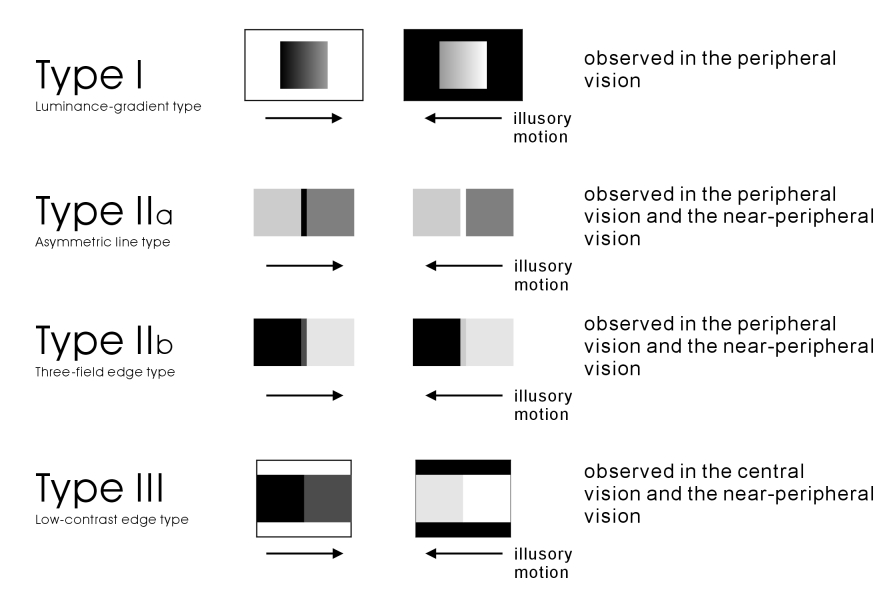
Imaging studies of the human visual cortex using fMRI techniques
(Kuriki, Ashida, Murakami & Kitaoka, in submission)

Test

Control
"Optimized Fraser-Wilcox" illusion, Type I
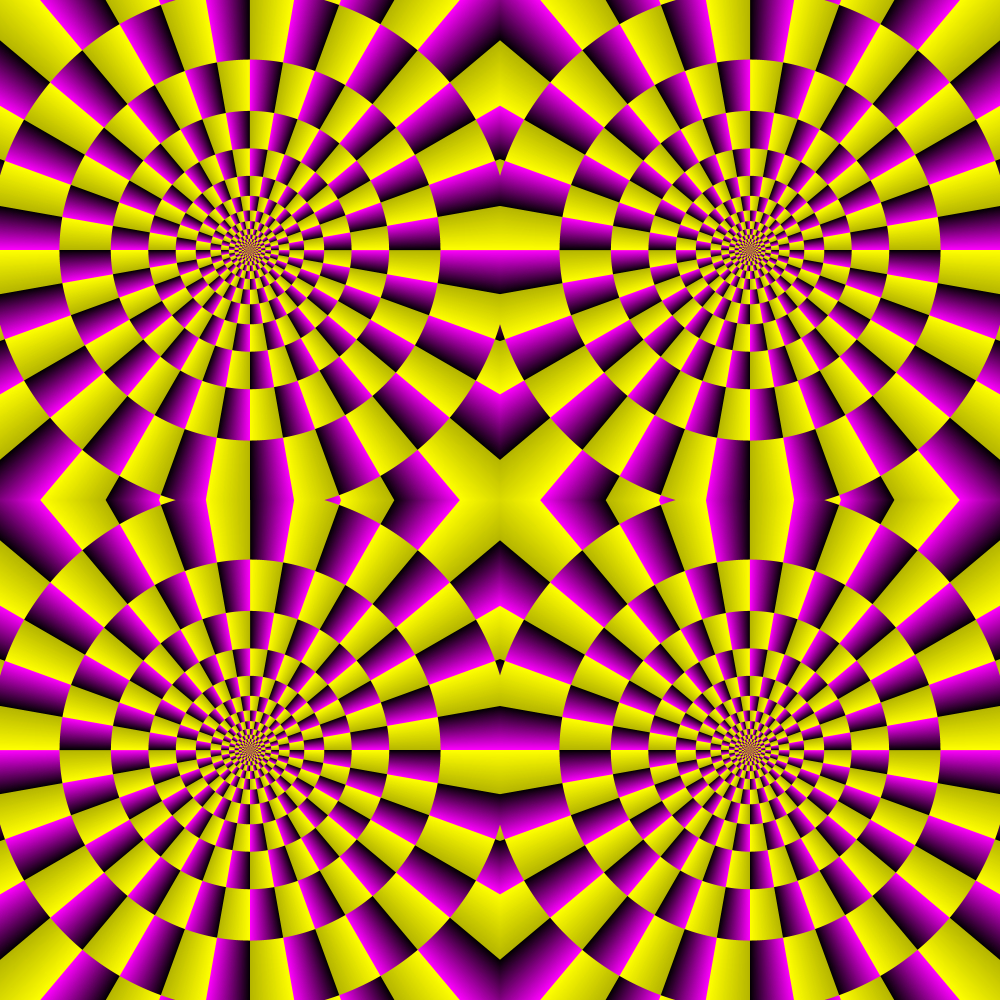
"The time tunnel show"
Rings appear to rotate.
Copyright Akiyoshi.Kitaoka 2006 (February24)
"Optimized Fraser-Wilcox" illusion, Type IIa
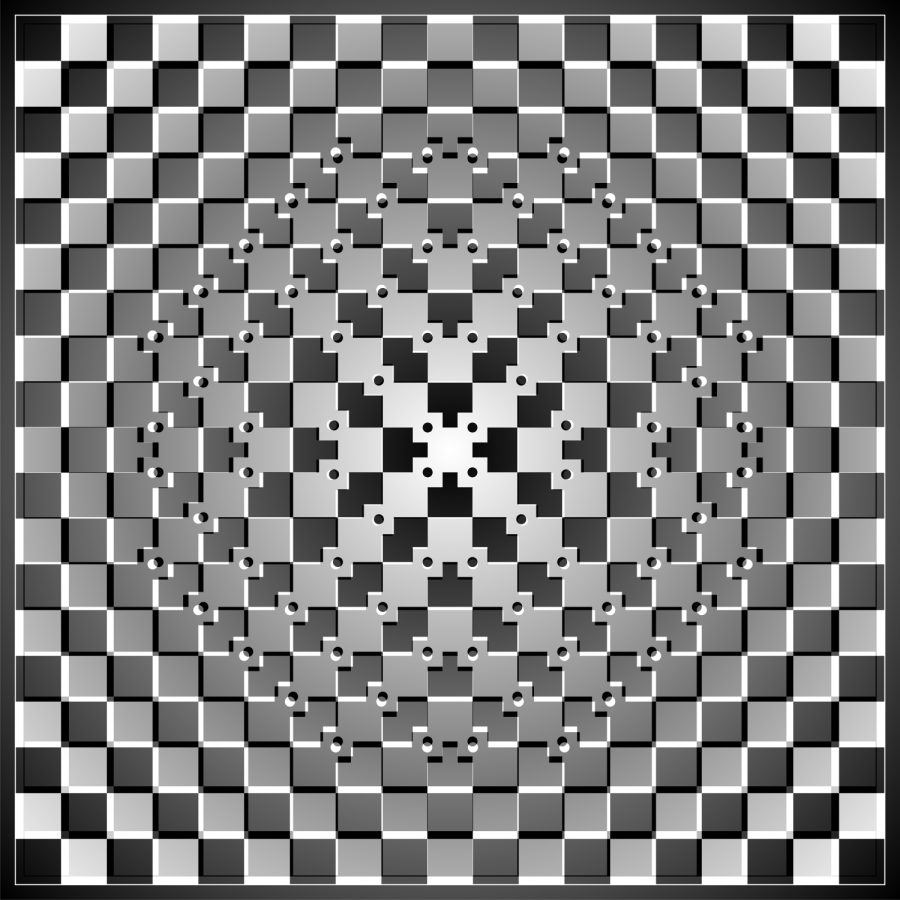
"Launch"
Something appears to be launched.
Copyright Akiyoshi Kitaoka 2008 (January 20)
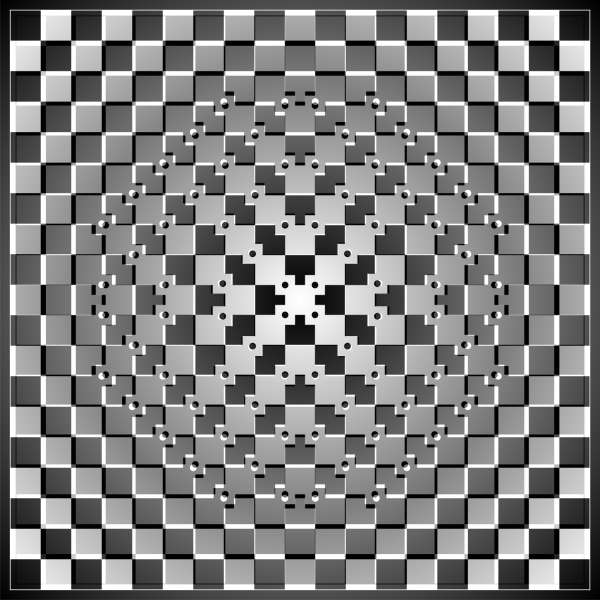
"Optimized Fraser-Wilcox" illusion, Type III
"Zig-zag worms"
The top and the third rows appear to move rightward while the rest appear to slide leftward.
Copyright Akiyoshi .Kitaoka 2007 (April 16)
Effects of color on the "optimized Fraser-Wilcox" illusion
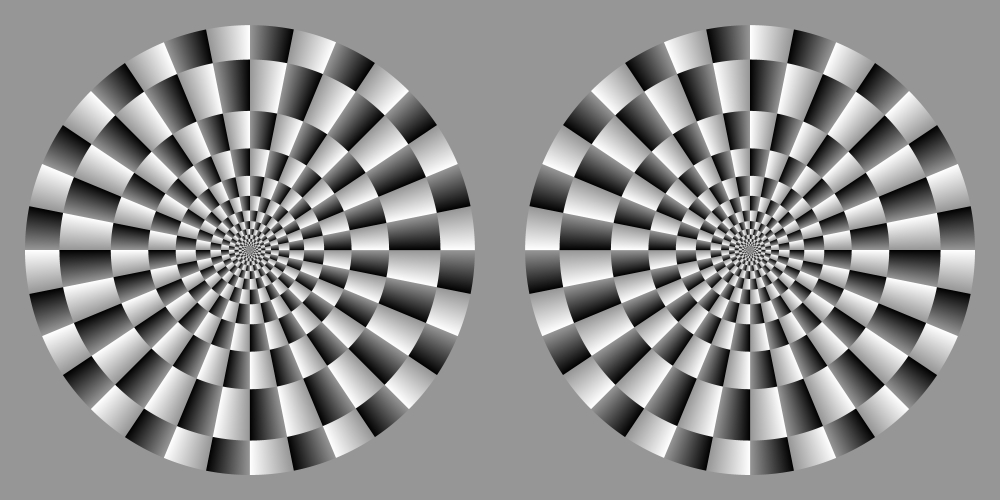
Black » Gray; White » Gray
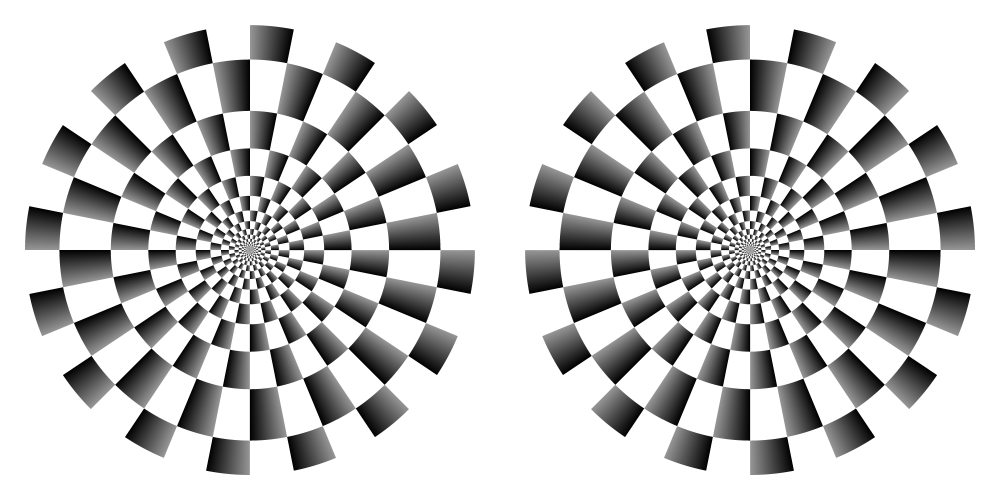
Black » Gray
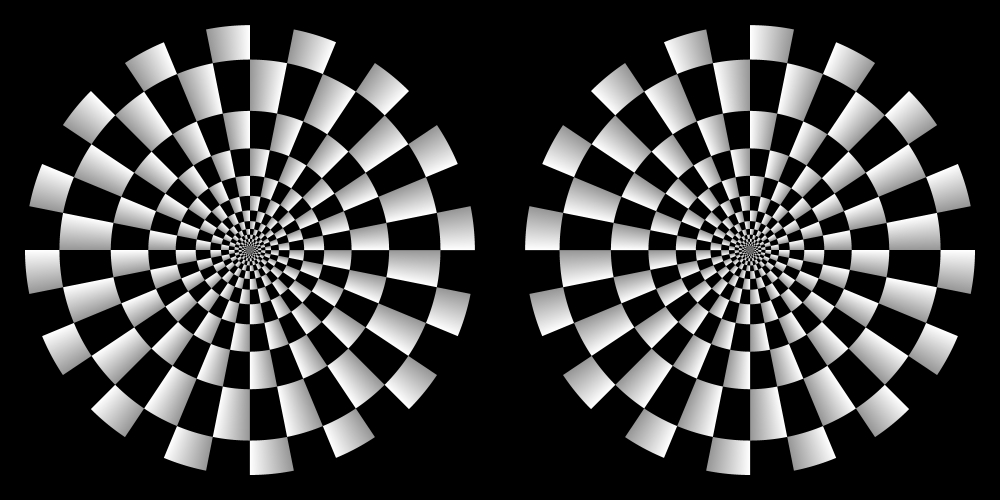
White » Gray
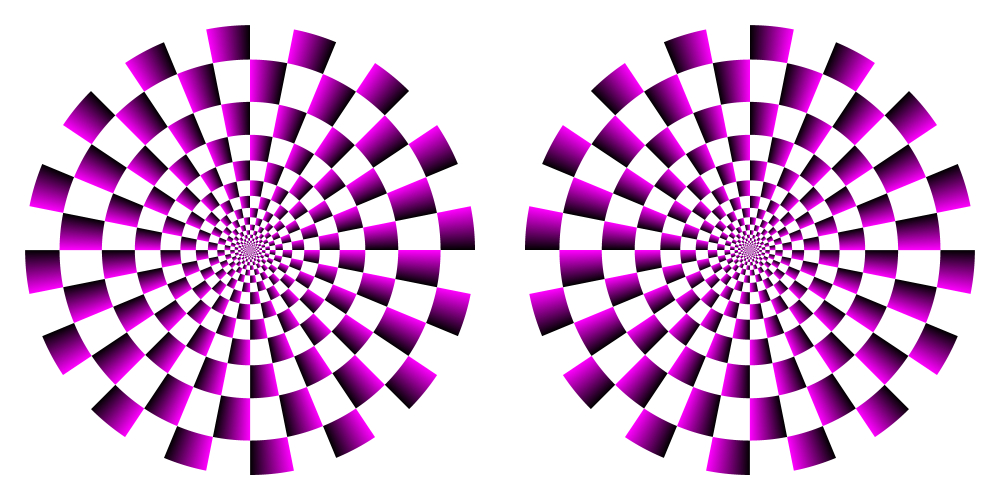
Black » Gray is replaced with Black » Magenta
Observation 1 The illusion from dark to light is enhanced by red or blue.
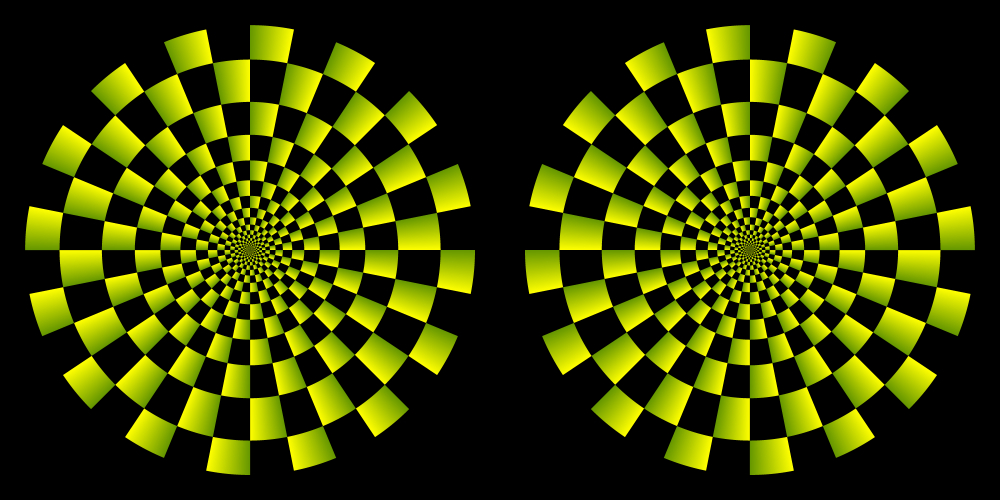
White » Gray is replaced with Yellow » Green
Observation 2 The illusion from light to dark is enhanced by yellow or green.
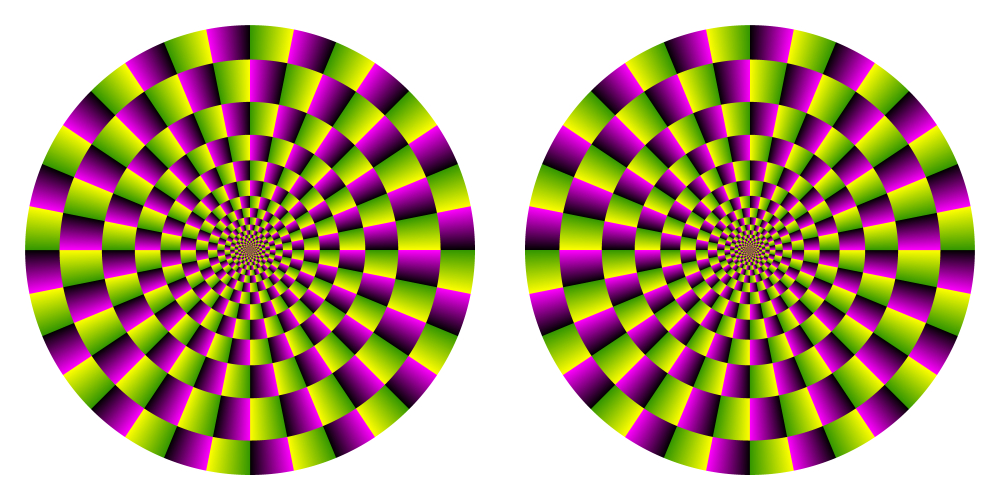
Black » Gray is replaced with Black » Magenta
White » Gray is replaced with Yellow » Green
Observation 3 The illusion from dark to light is enhanced by red or blue, and the illusion from light to dark is enhanced by yellow or green. Both illusions work additively.
 Suggested underlying mechansims
Suggested underlying mechansims
There are three explanations shown below.
Murakami, I., Kitaoka, A. and Ashida, H. (2006)
A positive correlation between fixation instability and the strength of illusory
motion in a static display. Vision Research, 46, 2421-2431. PDF
Backus, B. T. and Oruç, I, (2005) Illusory motion from
change over time in the response to contrast and luminance. Journal of
Vision, 5, 1055-1069. to get PDF
Conway, R. B., Kitaoka, A., Yazdanbakhsh, A.,
Pack, C. C., and Livingstone, M. S. (2005) Neural basis for a powerful static
motion illusion. Journal of Neuroscience, 25, 5651-5656. PDF
 A plausible explanation
A plausible explanation
Parts of high contrast appear faster than those of low contrast, then "high-to-low".
高コントラスト領域が先に見え、低コントラスト領域が後で見えるとすれば、その方向に動いて見えるという考え方
ところが
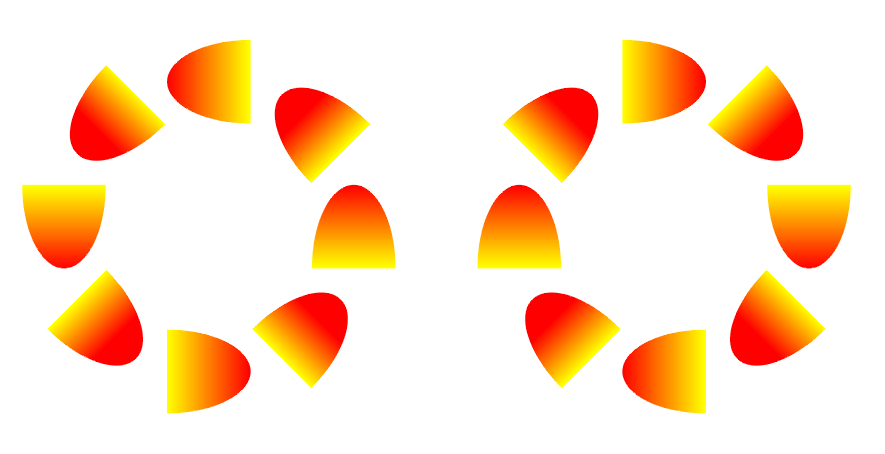
"Rotating carrots 2"
Rings of carrots appear to rotate slowly.
Copyright Akiyoshi.Kitaoka 2006 (February 17)
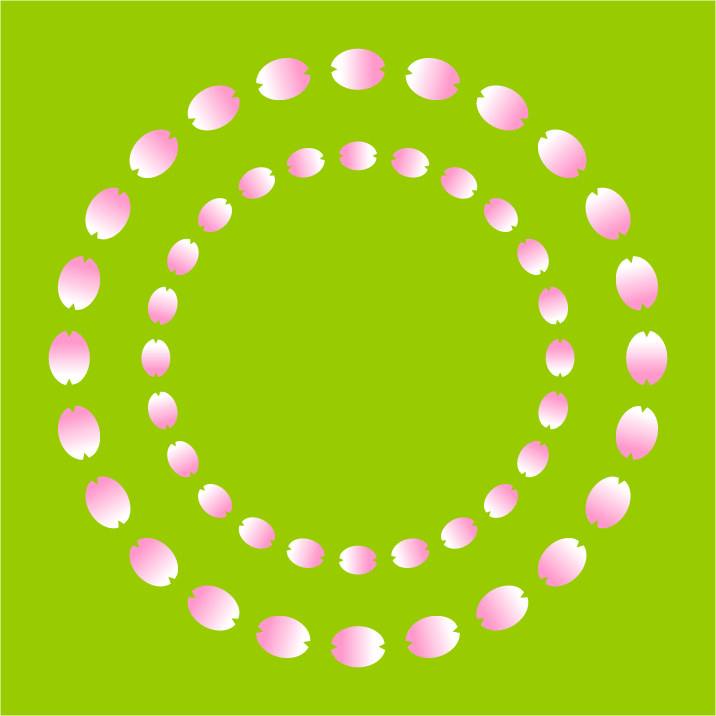
"Rotating sakura"
(a remake)
Rings made up of petals of cherry blossoms appear to rotate. The outer ring rotates counterclockwise while the inner one rotates clockwise.
Copyright Akiyoshi Kitaoka 2005 (January 26)
"Central drift illusion"
「中心ドリフト錯視」
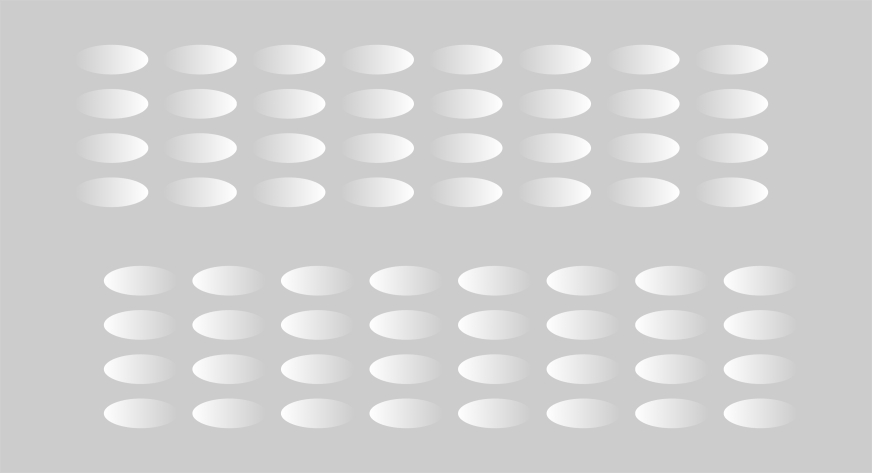
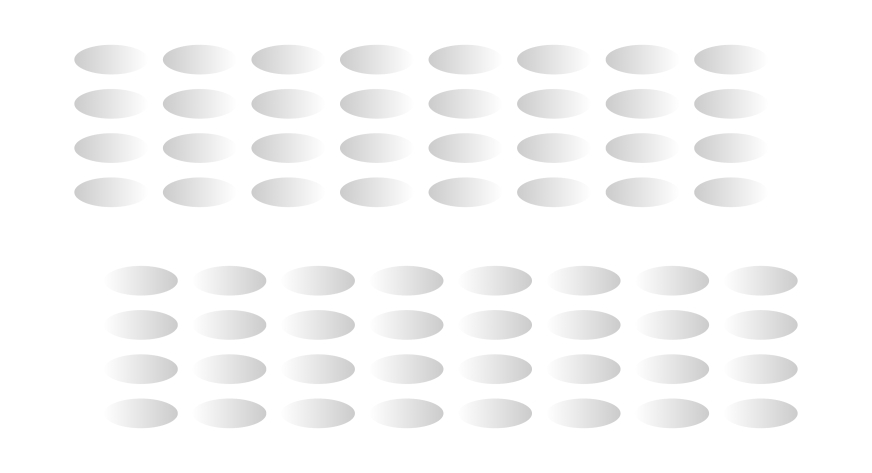
The direction of illusory motion is "low-to-high" in the central drift illusion.
中心ドリフト錯視では、錯視的動きの方向は、低コントラストから高コントラストの方向である。
Kitaoka, A. and Ashida, H. (2004) A new
anomalous motion illusion: the "central drift illusion". The 2004's winter meeting of the Vision Society
of Japan at the Kogakuin University, Shinjuku, Tokyo, Japan, 2004/1/26-28, 1/26 oral
publication. Presentation (html)
Individual differences in Rotating snakes illusion
蛇の回転の個人差について
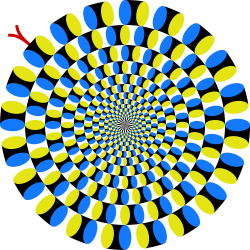

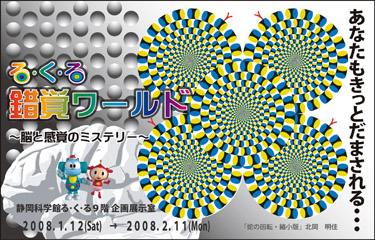
The relationship between the "Rotating snakes" illusion and age has been examined several times. Here are additional data from participants of my talk (in Japanese) in the Shizuoka Science Museum "Ru-ku-ru". The items for answer were "Rotating snakes appear to move well" (score 3), "Rotating snakes appear to move" (score 2), "Rotating snakes appear to move slightly" (score 1), and "Rotating snakes do not appear to move at all" (score 0). As a result, young people tend to see this illusory rotation strongly. <February 11, 2008>

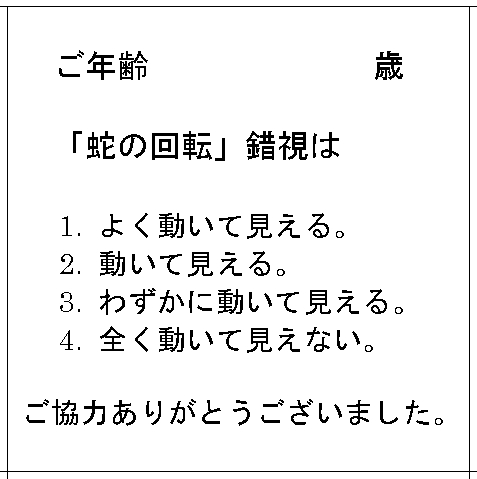
Survey card
Results
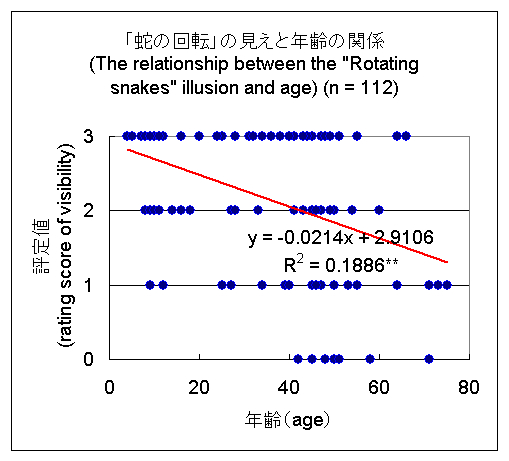
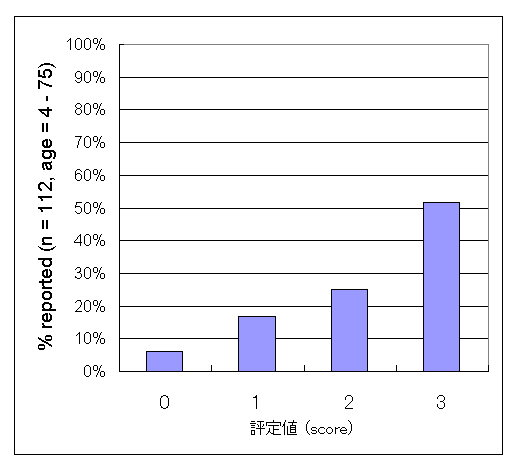
Data from participants of the Shizuoka
Science Museum "Ru-ku-ru" (February 10, 2008). For scores, see text.
The graph shown below displays
the combined data that have been collected so far. A strong negative correlation
(r = -.46) was found between the Rotating Snakes illusion and age! This does not
necessarily mean that the older the observer is, the less visible the illusion.
This indicates that some unknown characteristics of this illusion are related to
age while this illusion is not related to aging.
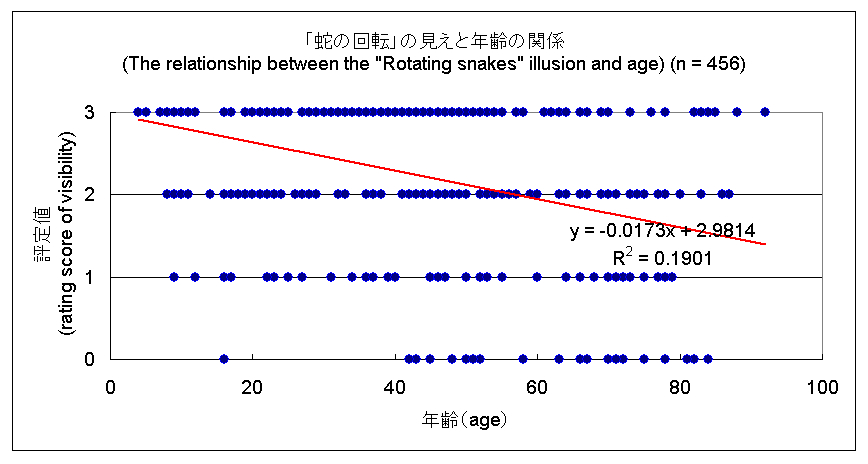
For those who do not see the "Rotating snakes" illusion, please do not worry because "no illusion" does not mean anything. It is only one of the individual differences. Please enjoy other illusions!
東京大学数理科学研究科で開催された非線形数理東京フォーラム「人と自然の数理」において、北岡は「錯視と数学」というタイトルでトークした(2008年2月2日(土))が、その時の来場者に協力して頂いて、「『蛇の回転』の錯視は若いほどよく見える」という仮説を調べるために、「蛇の回転」錯視が見えるかどうかを調査した。図はA4版の用紙に印刷したものを配布した(エプソン写真用紙クリスピア使用)。今回は仮説がもう一つあって、「東京大学の若い人は『蛇の回転』が見えにくい」というものであった。
これまでの図示の様式に従うと、結果は下図の通りであった。43名のご協力を頂いた。この調査ではこれまでの最年少の11歳から、66歳までの方にご協力頂いた。「蛇の回転」錯視と年齢の相関係数は、 r = -.41 で、この相関は統計学的に有意(p < .01)であった。これには11歳の方と66歳の方のデータが強く影響しているが、これらをはずしても相関係数は r = -.34 で、5%有意であった。すなわち、「蛇の回転」錯視の強さと年齢との間には、強いとまでは言えないが、有意な逆相関があった。「東京大学の若い人は『蛇の回転』が見えにくい」という仮説については、特にそれらしい兆候は観測されなかった。
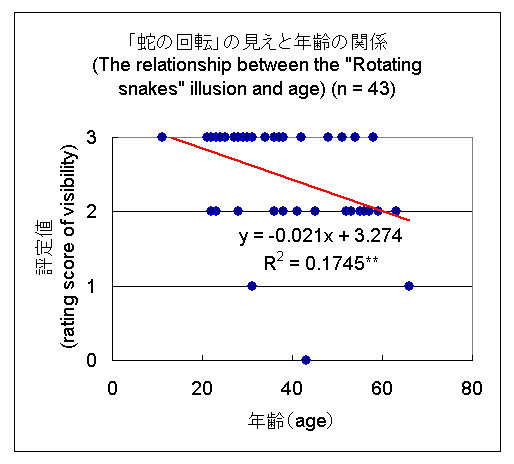
評定値3は「よく動いて見える」、2は「動いて見える」、1は「わずかに動いて見える」、0は「動いて見えない」である。
評定値の割合を示したのが下図である。大学生や高校生だけで調べたデータと比較すると、「よく動いて見える」人の割合が少ないことがわかる。少ないと言っても、半数を超えているが、20歳代の方が多かった影響かもしれない。
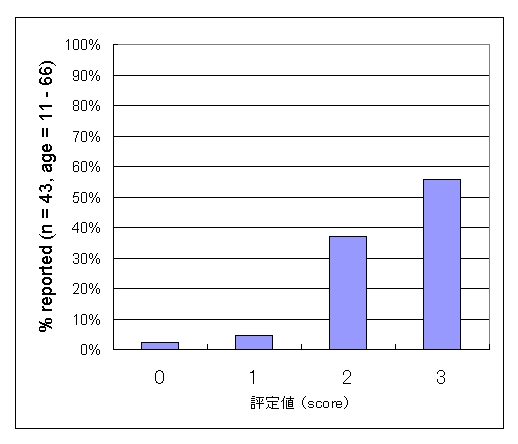
評定値3は「よく動いて見える」、2は「動いて見える」、1は「わずかに動いて見える」、0は「動いて見えない」である。
この錯視が見えなかった方へ。個人差ですので、心配しないで下さい。錯視が見えた方がたぶん面白いのですが、仕方ないです。私にも、言われている通りに見えない錯視があります。どうぞ、他の見える錯視を楽しんで下さい。
今回のデータ(東大・数理のフォーラムの来場者の皆様)に、前回のデータ(立命館大学の情報処理心理学 I の受講生の皆様)、前々回のデータ(仙台育英高校の皆様)、前々々回のデータ(尼崎の高齢者の皆様)、前々々々回のデータ(難波市民センターの皆様)、前々々々々回のデータ(放送大学面接講義の皆様)を込みにすると、下図のようになった。若い人のデータで「よく動いて見える」と回答した人が多かったのと、高齢者に「動いて見えない」という回答が少なくなかったことから、「蛇の回転」錯視と年齢の相関係数は
r = -.46 と絶対値が大きく、この相関は統計学的に有意(p <
.01)であった。「若いとみんな見えて、トシを取ると見えなくなる」という関係にあるわけではないが、サンプル数が十分あると無視できない強さで逆相関が現れる(しかも、その年齢に関係した性質の強弱は生活の質にはまったく影響がない)ということが、ほぼ確実になった。何を意味しているんだか・・・ 少なくとも、老化とは関係がない。
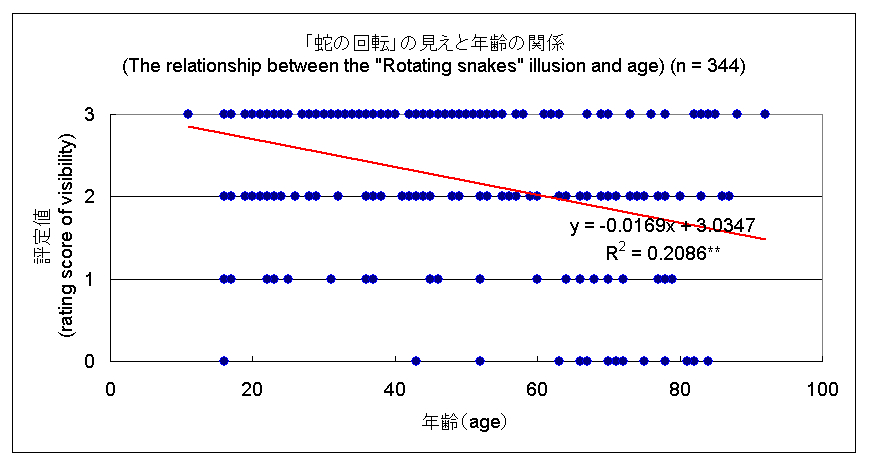
非線形数理東京フォーラム「人と自然の数理」にご参加の皆様、ご協力ありがとうございました。なお、「東京大学の若い人は『蛇の回転』が見えにくい」という仮説は、特に実証されませんでしたが、ご来場の若い方が東大以外の方だったかもしれないので(東大の人が多かったとは思いますが)、手続き上は何も検証したことになっておりません、念のため。 <2008年2月4日>
 結果は、錯覚ニュース9に掲載いたします。
結果は、錯覚ニュース9に掲載いたします。
3. Oblique-line-type motion illusion
retinal-slip-dependent anomalous motion illusion characterized by oblique
lines
斜線のある静止画が動いて見える錯視
網膜像の動きによって引き起こされるタイプで、斜線が重要な役割を果たしているもの
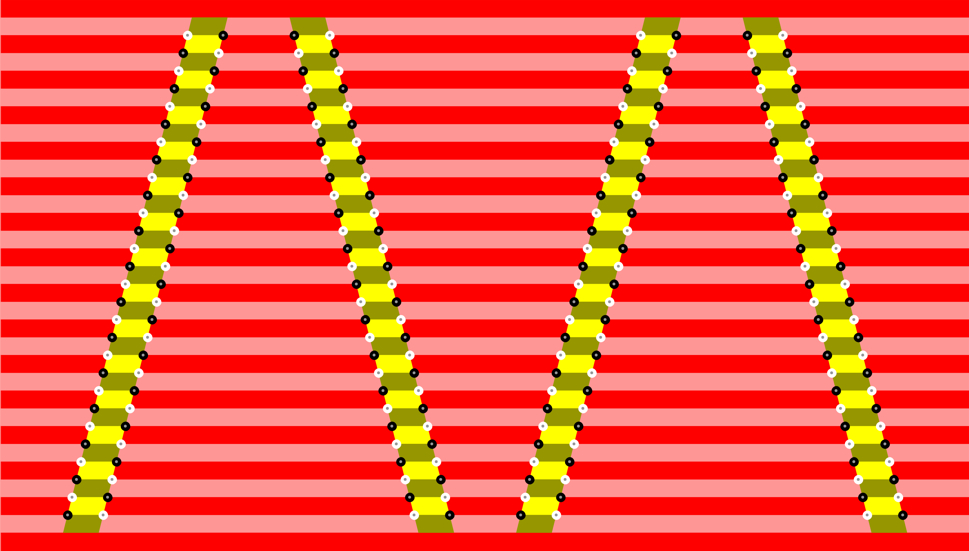
"Makudonarudo"*
A remake
*McDonald's pronounced in Japanese
Bars appear to move laterally.
Copyright Akiyoshi Kitaoka 2005 (November 3)
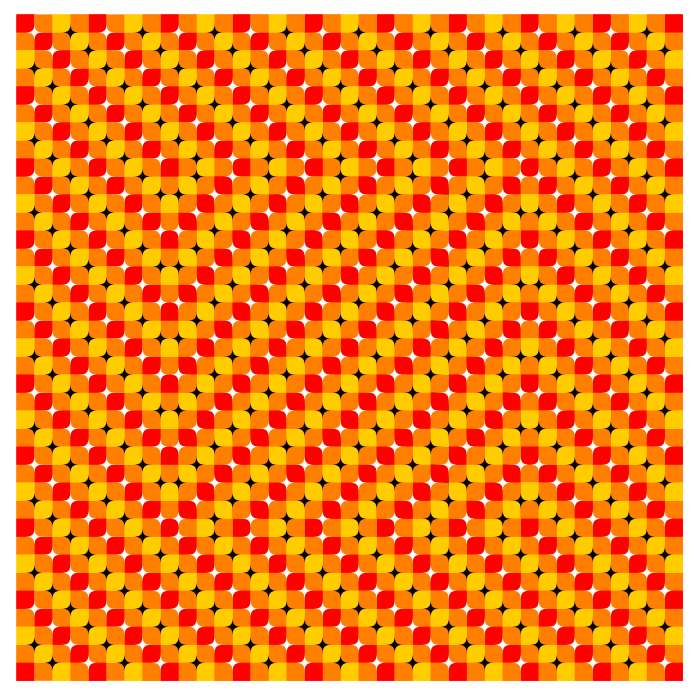
"The autumn color
swamp"
re-renewal version
The inset appears to move.
Copyright A.Kitaoka 2000, 2003, 2007
 Handout PDF of this type of illusion
Handout PDF of this type of illusion
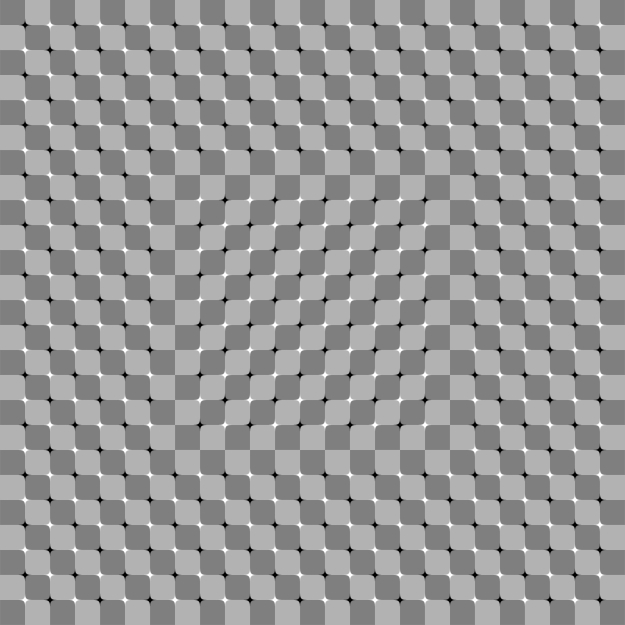
Illusion of Y-junctions
The inset appears to move according to retinal slips of the image. For example, the inset appears to slide leftward when upward retinal slip occurs; the inset appears to move upward when leftward retinal slip occurs. Moreover, there is a tilt illusion. For example, the vertical edges of the inset appear to tilt clockwise while the horizontal ones counterclockwise.
Kitaoka, A., Pinna, B., and Brelstaff, G. (2001). New variations of spiral illusions. Perception, 30, 637-646. PDF
Kitaoka, A., Pinna, B., and Brelstaff, G. (2004). Contrast polarities determine the direction of Cafe Wall tilts. Perception, 33, 11-20. PDF
Kitaoka, A. (2007) Tilt illusions after Oyama (1960): A review. Japanese Psychological Research, 49, 7-19. PDF
 Suggested underlying mechanisms
Suggested underlying mechanisms
1. Components of lower spatial frequency (given by wavelet transform?)
2. Components of tilt illusions (given by wavelet transform?)
1. Components of lower spatial frequency?
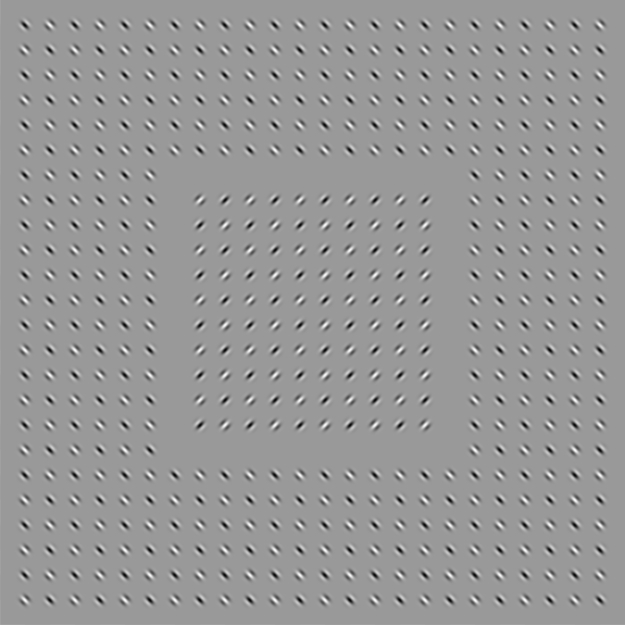
"Gabor patch drift illusion"
The inner square region appears to move. This is a translational representation of the Gurnsey-Morgan illusion.
Copyright Akiyoshi Kitaoka 2007 (August 6)
cf.
Gurnsey, R., Sally, S. L., Potechin, C., and Mancini, S. (2002) Optimising the Pinna-Brelstaff illusion Perception, 31, 1275-1280.
Morgan M, 2002 ``Running rings around the brain'' The Guardian Thursday, 24 January 2002; http://www.guardian.co.uk/Archive/Article/0,4273,4341518,00.html; http://www.staff.city.ac.uk/~morgan/TheWheel.pdf
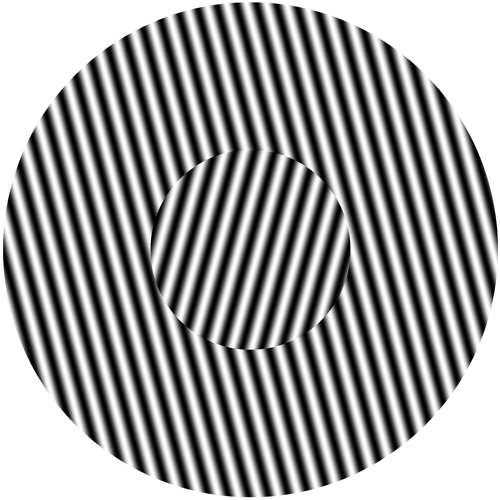
Hine illusion
Hine T J, Cook M, Rogers G T, 1995 “An illusion of relative motion dependent
upon spatial frequency and orientation” Vision Research 35 3093-3102
Hine T J, Cook M, Rogers G T, 1997 “The Ouchi illusion: an anomaly in the
perception of rigid motion for limited spatial frequencies and angles”
Perception & Psychophysics 59 448-455
2. Components of tilt illusions?
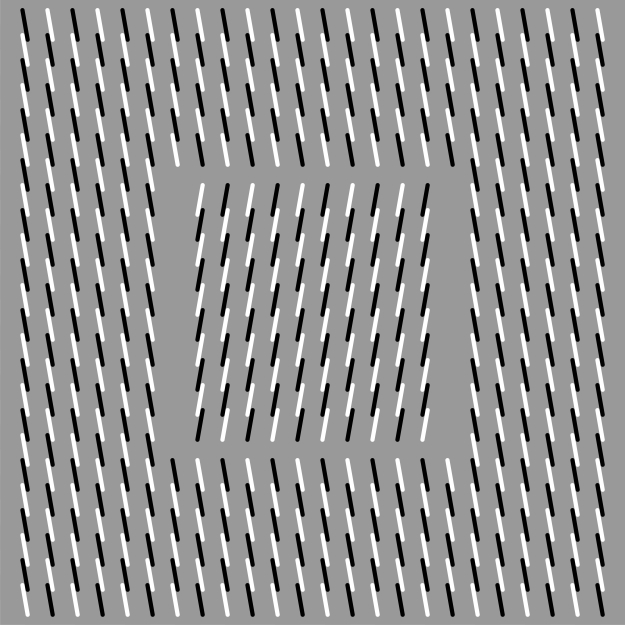
The inset appears to move horizontally when vertical retinal slips occur.
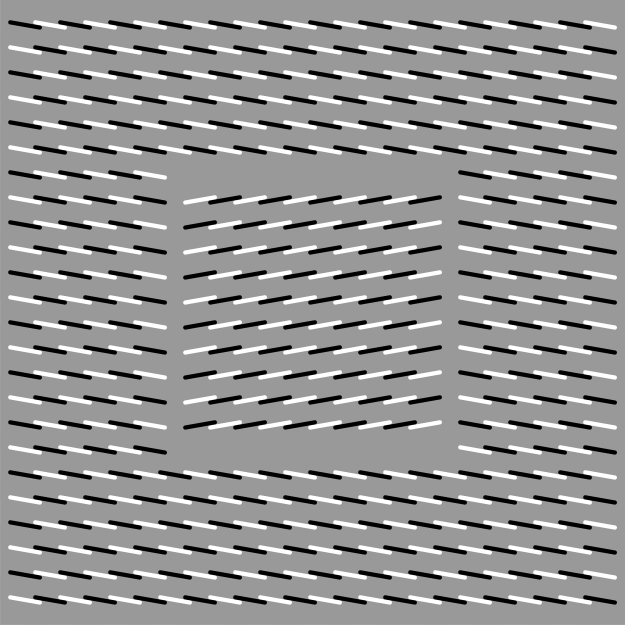
The inset appears to move vertically when horizontal retinal slips occur.
The illusion shown below can only be explained with mechanism 2

Illusion of fringed edges
The inset appears to move leftward when an upward retinal slip occurs.
The inset appears to move rightward when an downward retinal slip occurs.
The inset appears to move upward when an rightward retinal slip occurs.
The inset appears to move downward when an leftward retinal slip occurs.
The vertical edges of the inset appears to tilt clockwise.
The horizontal edges of the inset appears to tilt clockwise.
Newton Press (Ed.), A. Kitaoka (Supervisor)
(2007) Newton magazine book: Special
issue "How is the brain deceived? Perfect demonstration of visual
illusions" (published in
October 2007) ![]()
床屋のポールの錯視(barberpole illusion)
Kitaoka, A. and Murakami, I. (2007) Rotating Ouchi illusion. Poster presentation in VSS2007, Sarasota, Florida, USA, May 15, 2007. Abstract (MS-Word) VSS2007 Abstract (including all) (PDF)
(Kitaoka, A., & Murakami, I. (2007). Rotating Ouchi illusion [Abstract]. Journal of Vision, 7(9):984, 984a, http://journalofvision.org/7/9/984/,doi:10.1167/7.9.984.)
 Handout 上の写真の学会発表ポスター
Handout 上の写真の学会発表ポスター
4. Spiral illusion
an illusion that concentric circles appear to be spirals
渦巻き錯視
同心円(中心が同じ複数の円)が渦巻きに見える現象
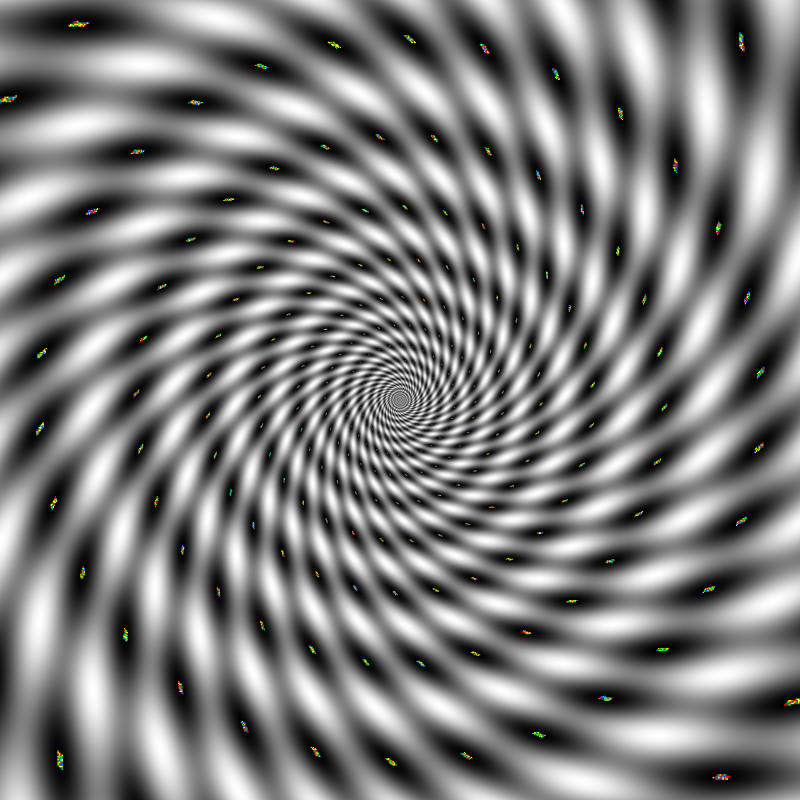
"Spiral warp"
Concentric rings appear to be spirals.
Copyright Akiyoshi Kitaoka 2007 (June 29)
equiangle = 45 deg
The spiral illusion of the Zöllner illusion:
Kitaoka, A., Pinna, B., and Brelstaff, G. (2001). New variations of spiral illusions. Perception, 30, 637-646.
"Spiral blood vessel"
Red concentric rings appear to be spirals.
Copyright Akiyoshi Kitaoka 2007 (June 26)
The spiral illusion of the Fraser illusion (Fraser spiral):
Fraser, J. (1908) A new visual illusion of direction. British Journal of Psychology, 2, 307-320.
The Fraser illusion of this type:
Skillen, J., Whitaker, D., Popple, A., and McGraw, P. V. (2002) The importance of spatial scale in determining illusions of orientation. Vision Research, 42, 2447-2455.
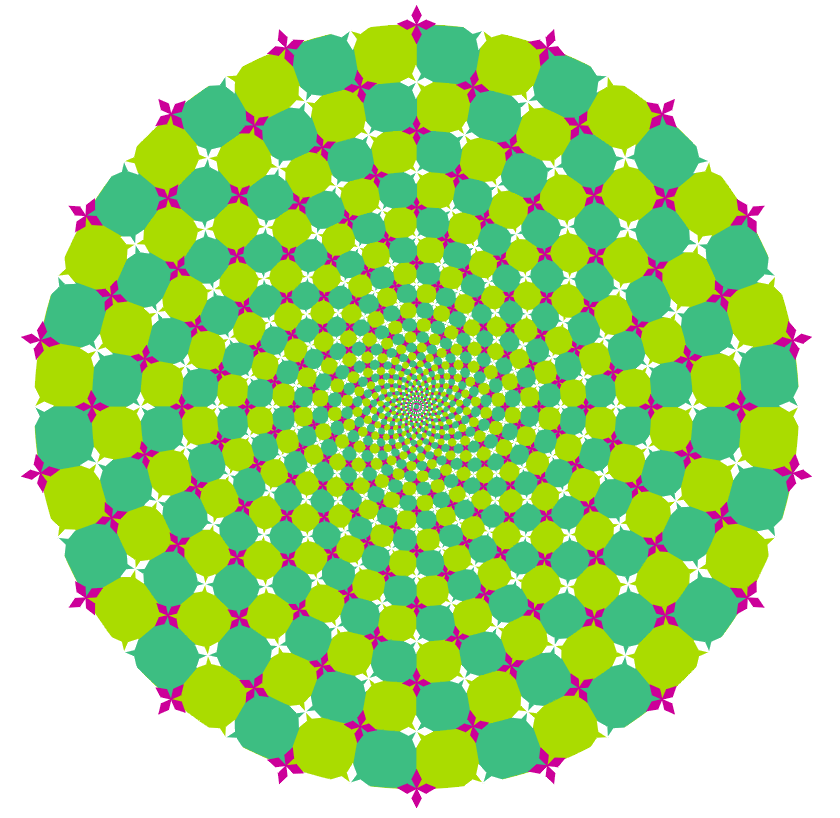
"Primrose's spirals"
Concentric arrays of "flowers" appear to be spirals.
Copyright A.Kitaoka 2002
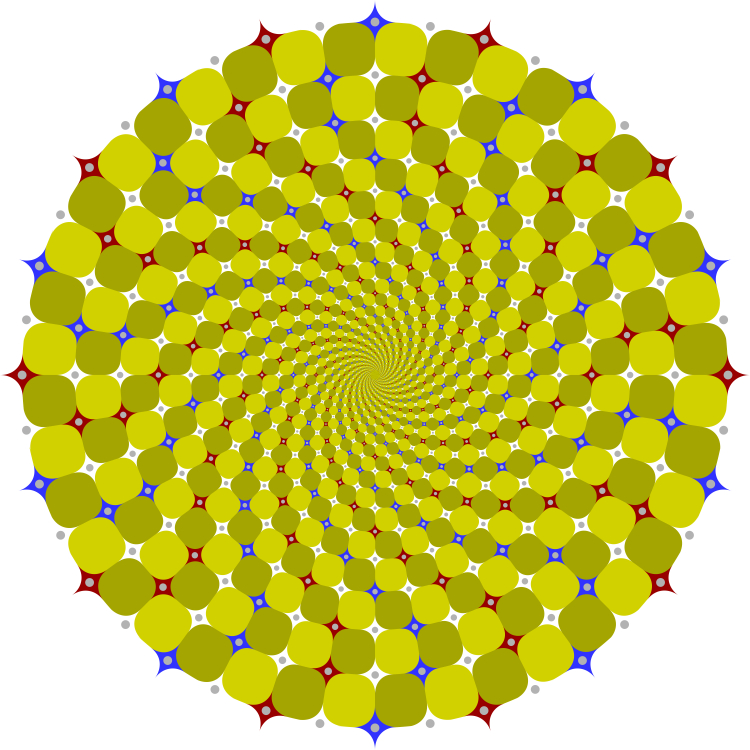
"Neural circuit spirals 2"
Concentric circles appear to be spirals (going to the center by rotating clockwise). Moreover, the inner part appears to rotate clockwise (counterclockwise) when observers approach (move away from) the image keeping their eyes fixed at the center.
Copyright Akiyoshi Kitaoka 2007 (August 7)

"Songs of
frogs"
(a remake)
Concentric arrays of dots appear to be spirals.
Copyright Akiyoshi Kitaoka 2008 (January 2008)
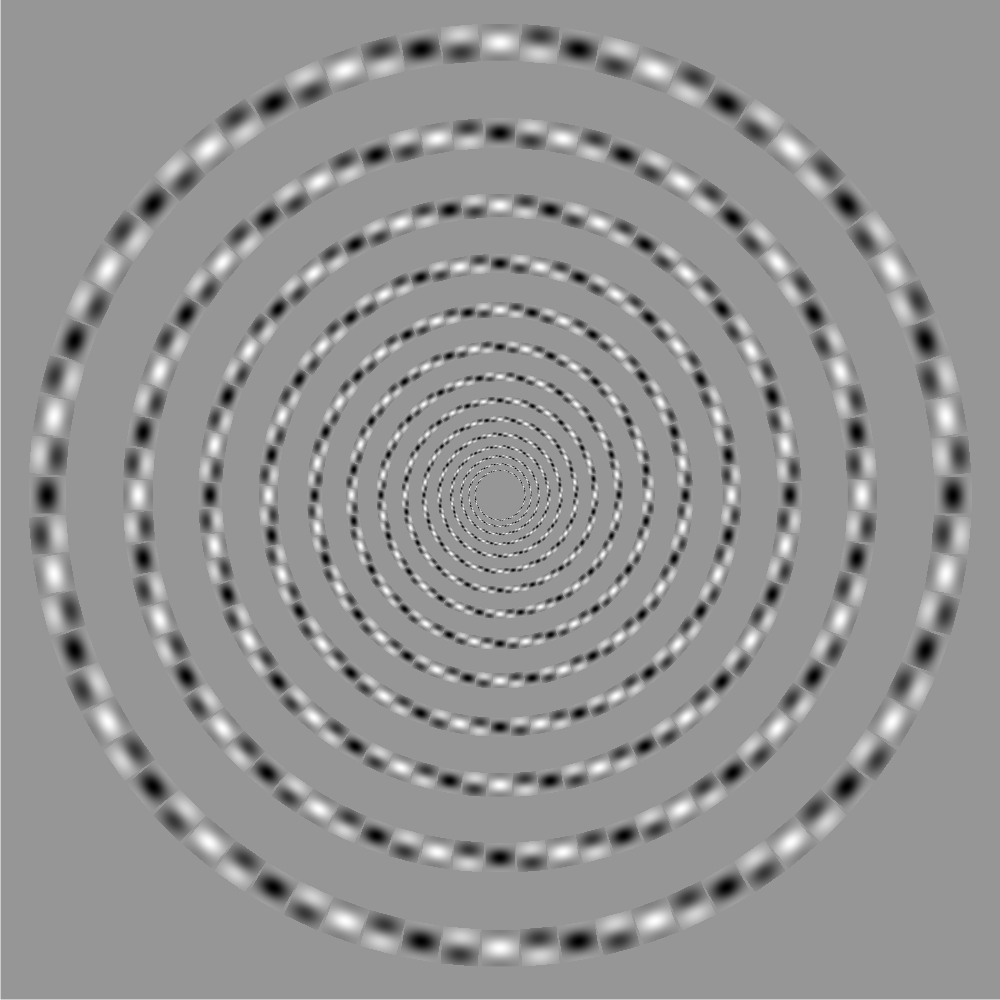
"Cyanophyceae spiral"
Concentric circles appear to be a spiral.
Copyright Akiyoshi Kitaoka 2007 (August 29)
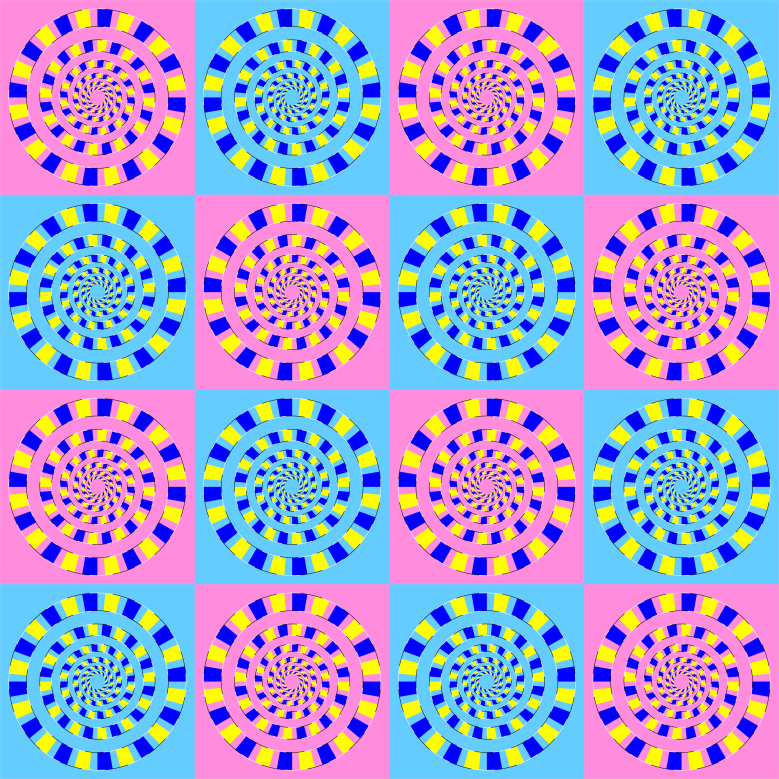
"Packed spirals"
Concentric rings appear to be spirals. Moreover, each set of rings appears to rotate.
Copyright Akiyoshi Kitaoka 2006 (June 13)
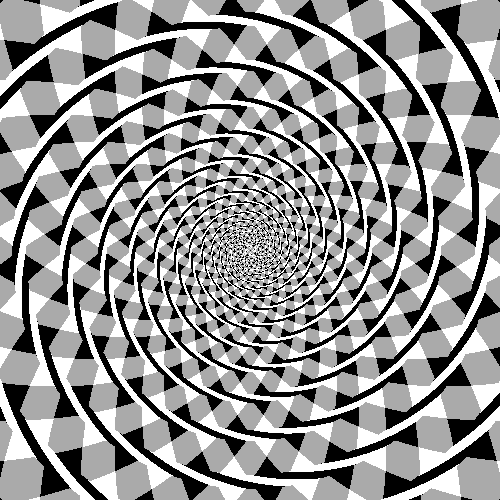
First presented by Fraser (1908); Reproduced by Akiyoshi Kitaoka (2003)
Fraser's spiral
The term "spiral illusion" had long referred to the spiral illusion of the Fraser illusion (Fraser, 1908) before we elucidated that any tilt illusion can form spiral illusion (Kitaoka, Pinna and Brelstaff, 2001). This page shows a copy of Fraser's spiral produced by PC programming. <2003/8/30>
Fraser, J. (1908) A new visual illusion of direction. British Journal of Psychology, 2, 307-320.
Kitaoka, A., Pinna, B., and Brelstaff, G. (2001). New variations of spiral illusions. Perception, 30, 637-646. PDF
 Handout
Handout
Catalogue of spiral illusions (in Japanese)
北岡明佳 (2006) 渦巻き錯視のメカニズム じっきょう数学資料, 52, 13-15. PDF
 Suggested function
Suggested function
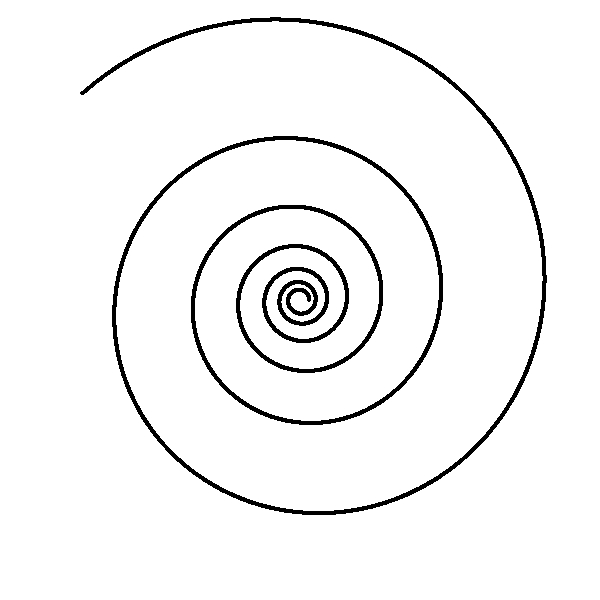
Bernoulli's spiral
r = a exp (k θ)
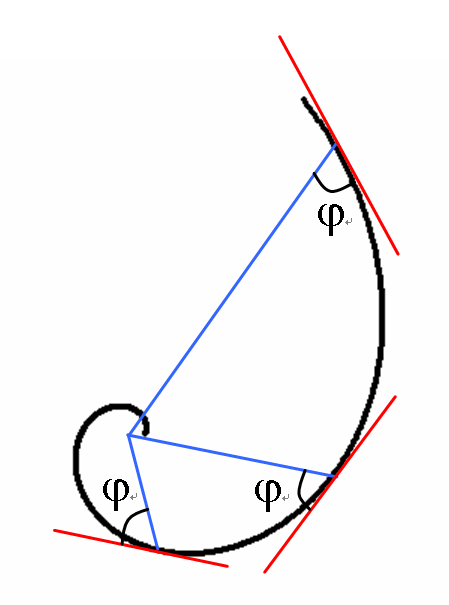
= equiangular spiral
k = 1 / tan (φ)
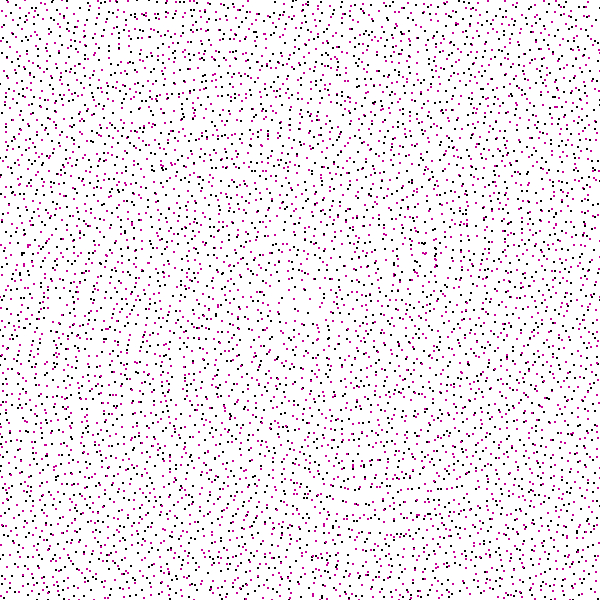
Spiral Glass pattern
φ = 70º
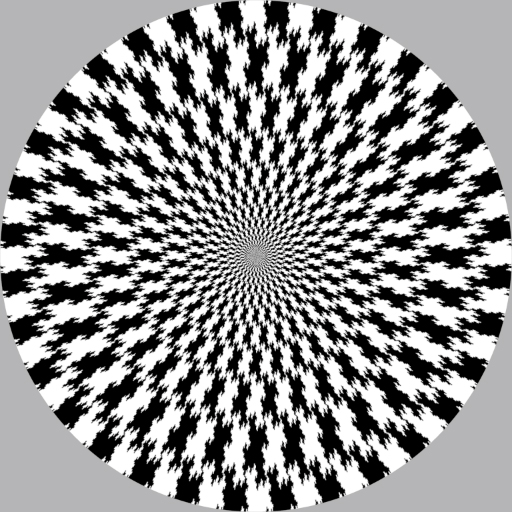
"Fractal spiral illusion"
Concentric rings made up of fractal islands appear to form spirals.
Copyright Hitoshi & Shinobu Arai
2007
from Professor Hitoshi Arai,
Graduate School of Mathematical Sciences, University of Tokyo, October 4,
2007
北岡明佳のコメント: 原理としてはフレーザー錯視のようですが、それよりもなによりも、世界初のフラクタル錯視図形 なのではないでしょうか!? 新井先生の視覚数学e研究室報告に、この錯視の論文が出ました。 <2007年10月4日>
5. Color illusion
Contrast (-) vs. assimilation (+)
色の錯視
対比(+)と同化(-)
"The ground family"
The left pegion appears to be yellowish, but the color is the same white as the right.
Copyright Akiyoshi .Kitaoka 2007 (March 12)
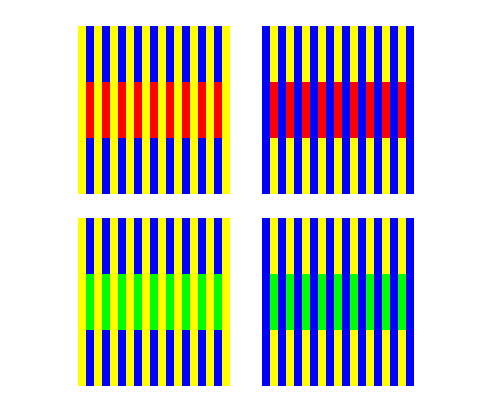
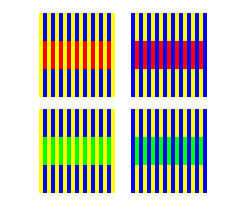
Munker illusion
The orange and purple-red shown in the upper row are the same red, and the yellowish-green and bluish green displayed in the lower row are the same green.
Munker, H. (1970) Farbige Gitter, Abbildung auf der Netzhaut und übertragungstheoretische Beschreibung der Farbwahrnehmung. Habilitationsschrift, Ludwig-Maximilians-Universität, München.
"Takeda Shingen"*
*Takeda Shingen = a sengoku-daimyo (leader in the Warring States period in the 15th and 16th century in Japan)
There appear to be pale-yellow and dark-blue spirals. Actually, in the left half, they are white (R=255, G=255, B=255) and black (R=0, G=0, B=0), respectively. On the other hand, in the right half, they are yellow (R=255, G=255, B=0) and blue (R=0, G=0, B=255), respectively.
Copyright Akiyoshi .Kitaoka 2007 (March 12)
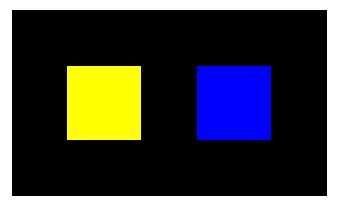
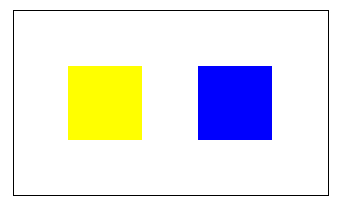
Color sample
"Furin-kazan"*
*Furin-kazan is a slogan of Takeda Shingen
There appear to be white, black, yellow and blue spirals as they really are.
Copyright Akiyoshi .Kitaoka 2007 (March 12)
 Suggested equations
Suggested equations
Induced color 1 = (+Red) + (-Magenta) = Red + Green = Yellow
Induced color 2 = (-Red) + (+Magenta) = Cyan + Magenta = Blue
"Carpet of blue and green hearts (Parts)"
There appear to be blue and green hearts, though they are identical in color.
Copyright Akiyoshi .Kitaoka 2007 (January 10)
cf. Dungeon illusion: Bressan, P. (2001) Explaining lightness illusions. Perception, 30, 1031-1046.
"Guruguru 6"
There appear to be two different colors in inner rings, though they are the same as each other.
Copyright Akiyoshi .Kitaoka 2007 (January 15)

&
&
(敬称略)
静止画が動いて見える錯視とそのfMRI研究 (Anomalous motion illusion and its fMRI study)
栗木 一郎 (Ichiro Kuriki) 東北大学電気通信研究所 (Tohoku University)
蘆田 宏 (Hiroshi Ashidai) 京都大学文学研究科 (Kyoto University)
村上 郁也 (Ikuya Murakami) 東京大学総合文化研究科 (University of Tokyo)
視覚芸術と「心のデザイン」モデルの研究 (Visual art and its mental design model)
行場 次朗 (Jiro Gyoba) 東北大学文学研究科 (Tohoku University)
三浦 佳世 (Kayo Miura) 九州大学人間環境学研究 (Kyushu University)
川畑 秀明 (Hideaki Kawabata) 鹿児島大学教育学部 (Kagoshima University)
錯視図形を用いた乳児の知覚発達の研究 (Infant development of perception of visual illusion)
山口 真実 (Masami Yamaguchi) 中央大学文学部 (Chuo University)
金沢 創 (So Kanazawa) 淑徳大学総合福祉学部 (Shukutoku University)

まとめ
Summary
錯視の脳研究はまだまだこれからである。
Brain studies of visual illusion would be fruitful in the future.
ご清聴ありがとうございました。
Thank you for listening.

Special thanks to Miyashita-sensei.